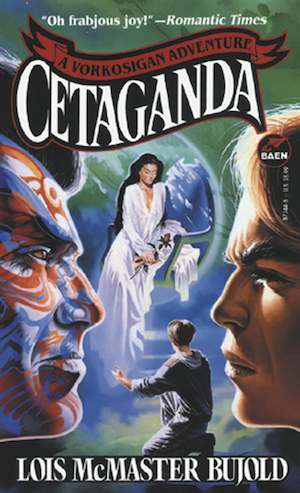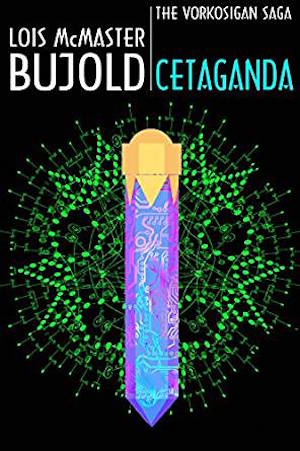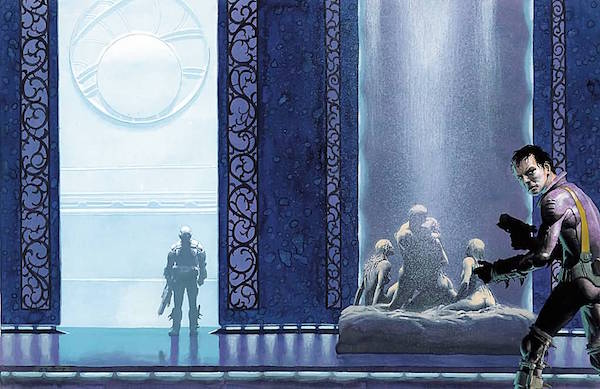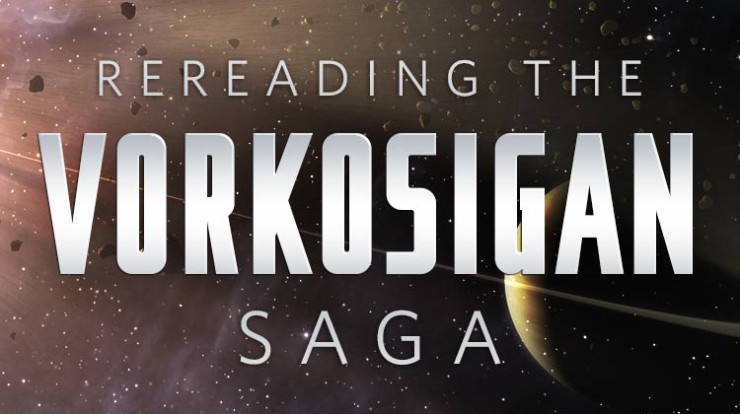This week, the re-read heads to Cetaganda, in Cetaganda! The exclamation point in this case is my addition, and not part of the title like in Oklahoma! This book was first published in 1996, appearing on the shelves between Mirror Dance and Memory, but it’s the sixth book in current reading order. At the beginning of the story, Miles and his cousin Ivan are dispatched to represent the Barrayaran Empire at the funeral of the Cetagandan Emperor’s mother. In some senses, the boys are on their Grand Tour, putting the final touches on a galactic education and getting some practice in doing the things the High Vor do. It’s also a neat little mystery—sort of “Sherlock Vorkosigan.”
Sort of. There’s a lot you can say about Miles, but you certainly can’t say that he’s spent any significant time studying exotic poisons or Cetagandan politics. He’s in pursuit of a mysterious missing object, a murderer, and a conspiracy, but unlike most literary detectives, he’s also a fish-out-of-water on Cetaganda. This works because Bujold deploys Ivan to carry most of the fish role. Ivan’s presence is also one of the reasons that Cetaganda makes a logical follow-up to The Vor Game. That book exposed a lot of the relationship between Miles and Gregor. This one does the same for Ivan. We see a lot of Ivan through the series as a whole—he plays a major role in many books and several important moments of crisis—but this is the most sustained time we get to spend with him as readers until Captain Vorpatril’s Alliance. When I first read these as a teenager, they struck me as a series of adventures and not as a multi-volume exploration of Miles’s relationships. They are, of course, both, and now that I see that, I would like to see Miles spend more quality time with Lady Alys.
What better way to dive in to Cetaganda than an enthusiastic cover blurb from the Romantic Times?

This is the original Baen hardcover edition. It features Miles twice, once in profile and once from the back, kneeling in front of the Haut Rian Degtiar. Miles is squaring off against one of the Cetagandan Ghem. The facepaint is fierce and intimidating, which is an interesting contrast to the sweats and hoodie ensemble Miles seems to be wearing in the background. I believe the artist has taken liberties with his Formal Vorkosigan House Mourning livery. Haut Rian is modelling Cetagandan high fashion, beginning with the force bubble that usually keeps Haut women concealed. I think a force bubble is a must-have accessory for people who attend garden parties in satin-y white bathrobes. It probably also defends the user from forces of nature that can cause difficulties to people with extraordinarily long hair. The artist, Gary Ruddell, also painted covers for some of the other books in the Vorkosigan series, including Mirror Dance, Memory and Komarr. He uses opposing character profiles a lot. This one evokes a superhero team-up comic, which is a nice analogy for the plot here.

The Kindle edition cover shifts focus from the characters in the book to its McGuffin—the key to the Rose Creche that holds the entire Haut Genome. This version of the seal looks a bit like a test tube and a bit like some kind of computer drive. It also looks a bit like the kind of healing crystal you buy at a Ren Faire, but I think that visual reference is probably unintentional. I like seeing the characters, but I also like the abstract simplicity of this series of covers. On the whole, they demonstrate a clear artistic vision while being true to the contents of the books.

My affection for this version is also an exponent of my love of the abstract, and not a reflection of, just for example, my ability to find an image of this cover at a resolution that allows me to really examine it in detail. The structure in the middle looks like one of Duchamp’s Readymades, and the standing figure—juvenile? skeletal?—inside the bubble suggests that the force shields hide the Haut’s vulnerability. The masks point to the uncertainty surrounding identity that concerns Miles at several points in the story. And, if I’m seeing this correctly, this edition of the book cost five Euros.

This cover, from the Croatian edition of the book, has abandoned all loyalty to the events of the story. At first glance, it looks like the group of figures just to the right of the center could be gathered around a funeral bier, perhaps discovering the Ba Lura’s corpse. On closer examination, that crowd is mostly nekkid, and not participating in a funeral ceremony for visiting dignitaries. Plus bonus guys with guns. If this represents anything, I think it’s probably Ivan’s rough night at Lord Yenaro’s party. The image certainly conveys a sense of exoticism and danger. It also suggests that the Cetagandan Ghem are into thongs. I take my background information on Cetagandan culture wherever I can find it.

This version of the cover also strays from the plot. Did someone ride a horse in this book and I missed it? I’m only halfway through my pre-reread as I write this. It could have happened. But not, I hope, like this. Come for the book covers, stay for the equitation critique! Although she is demonstrating an otherwise enviable leg position, this rider is on the brink of sliding her feet through the stirrups. This suggests that she is not entirely secure in the tack. She is also using a driving rein. It’s not the same kind of impending disaster as her feet, but it’s not the preferred method of applying a running martingale on a rearing horse. Either our rider is extraordinarily tall, or Cetaganda’s horses are unusually short. Or both! Haut control of the genome may create selection pressures that favor long legs and shrimpy horses.

This cover demonstrates the dangers of too much green. The gardens are lush, and the gentle glow of the force bubbles is charming. The architecture in the background evokes the nostalgia of 18th century Neoclassicism, which dovetails nicely with the idea that Miles and Ivan are on the Grand Tour. The Haut Rian Degtiar, however, looks like a zombie. Miles looks alarmed.
Next week—Miles arrives on Cetaganda and is alarmed, although not by the Haut Lady.
Ellen Cheeseman-Meyer teaches history and reads a lot.










